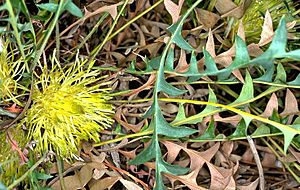Banksia octotriginta facts for kids
Quick facts for kids Banksia octotriginta |
|
|---|---|
 |
|
| In the ANBG | |
| Scientific classification | |
| Genus: |
Banksia
|
| Species: |
octotriginta
|
| Synonyms | |
|
Dryandra octotriginta A.S.George |
|
Banksia octotriginta is a type of shrub that grows only in the southwest part of Western Australia. It has straight stems, bluish-green leaves that are deeply divided, and clusters of up to eighty or more golden-yellow flowers. After flowering, it produces egg-shaped seed pods called follicles.
What Does It Look Like?
Banksia octotriginta is a shrub with straight stems. It usually grows to be about 0.25–1 m (9.8 in – 3 ft 3.4 in) tall. This plant does not form a special woody base called a lignotuber.
Its leaves are bluish-green and deeply divided, almost like a feather. They are 100–250 mm (3.9–9.8 in) long and 30–60 mm (1.2–2.4 in) wide. Each leaf has a stalk, or petiole, that is 30–60 mm (1.2–2.4 in) long. On each side of the leaf, there are ten to eighteen triangular sections.
The flowers are a pale golden-yellow color. They grow in clusters of fifty to eighty-five flowers at the ends of branches. At the base of these flower clusters are small, leaf-like parts called involucral bracts, which are 10–20 mm (0.39–0.79 in) long and covered with a rust color.
Each flower has a perianth (the outer parts of the flower) that is 35–43 mm (1.4–1.7 in) long. The pistil, which is the female part of the flower, is 40–48 mm (1.6–1.9 in) long and smooth. This plant flowers from July to August. After flowering, it produces egg-shaped seed pods, or follicles. These pods are about 13 mm (0.51 in) long and 12 mm (0.47 in) wide, and they have a few hairs on them.
How It Got Its Name
This plant was first officially described in 1996 by a scientist named Alex George. He found specimens of the plant near Nyabing in 1986. He named it Dryandra octotriginta.
The name octotriginta comes from a Latin word meaning "thirty-eight." This refers to the number given to this species in a list of new plants being studied by a group called the Dryandra Study Group.
Later, in 2007, two other scientists, Austin Mast and Kevin Thiele, moved all the plants from the Dryandra group into the Banksia group. That's why its name changed to Banksia octotriginta.
Where It Lives
Banksia octotriginta grows in a type of shrubland called kwongan. It often grows alongside mallee eucalypt trees. You can find this plant in an area between Woodanilling, Nyabing, Newdegate, and Dragon Rocks in Western Australia.
Its Future and Protection
Scientists have studied how climate change might affect this plant. They found that it could be at risk of losing its habitat by the year 2080, even if climate change is not very severe.
However, the Western Australian Government's Department of Parks and Wildlife currently lists Banksia octotriginta as "not threatened." This means it is not considered to be in immediate danger of extinction.

